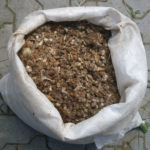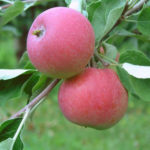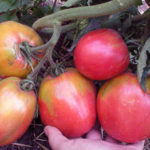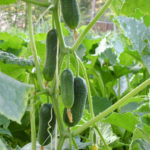Thuja western Miriam
Low-growing conifers can be seen today on many household plots. They are preferred because these plants take up little space and ennoble any territory. Thuja western with the eastern name Miriam (Thuja occidentalis Mirjam) just from the specified category of evergreen crops. Live it in your garden, and it will delight you with an attractive appearance all year round.
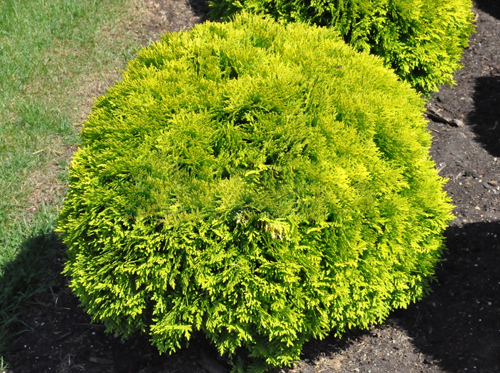
History of creation and description of the variety
The beauty Mirjam became known to the world quite recently, but has already gained popularity among European gardeners. This variety is a mutation of Danica. It boasts a dense crown of the correct spherical shape and scaly shiny needles of a golden hue. The plant barely reaches a meter in height, rarely more than 80 cm in width.For its miniature size, this variety is called a coniferous dwarf.
Slow growth is also a feature of Miriam. In a year, the height of the thuja increases by only 5-10 cm. It is interesting that its needles with the onset of winter change their usual color to a green-orange color with a bronze tint. However, in the spring, she again begins to play with bright yellow colors. The plant has a superficial root system and a vertical arrangement of tightly adjacent needles, forming a symmetrical crown.
The ornamental shrub has good winter hardiness: it is not afraid of frosts down to -35 ° C. It is characteristic of coniferous crops and has good resistance to diseases. Pest insects also rarely attack the miniature beauty. However, in winter, thuja can fall prey to sunburn.
Agrotechnical features
Miriam loves well-lit places. It should not be placed in the shade, otherwise the needles of the culture will lose their beautiful natural shine, become looser, and the golden color of the needles will fade. Penumbra is quite suitable for growing this species of evergreen. The culture dislikes cold winter winds, does not tolerate low air humidity and soil overconsolidation. It should be planted in nutritious, humus-rich, loose, light, moderately moist soil with a slightly acidic reaction and good drainage. The best option is loam that meets all of the above conditions.

Before planting in the selected area, dig a hole 60-80 cm deep. Prepare the soil mixture in advance. To do this, in a ratio of 2: 1: 1, the following components are combined: sod land, sand and peat. The drainage layer at the bottom of the hole should be at least 10 cm thick. The soil is covered with soil so that its root collar is at ground level. Immediately after planting is completed, the ephedra is watered abundantly. A globular shrub needs regular and careful maintenance. It needs to be watered 1-2 times a week. An adult plant requires 10-15 liters of clean, settled water at room temperature at a time. Since this is a moisture-loving variety, it is recommended to spray the crown more often, especially in the hot summer period.
Miriam is responsive to feeding. They are best done in the spring with a suitable mineral complex. It is also good to water the plant under the root with a solution of organic fertilizer, and add ash to the soil under the shrub. To maintain good water and air permeability of the soil, it is periodically loosened. This procedure is carried out exclusively after watering, while the ground is still wet. It should be remembered about the superficial nature of the thuja root system and do not loosen the soil too deeply. Then, the soil is mulched in the zone of the near-trunk circle with crushed pine bark, peat or compost.
The variety tolerates pruning and shaping cut excellently. In the spring, before the appearance of buds, it is deprived of dry and damaged shoots and those that contribute to the thickening of the crown. To maintain the spherical shape of the shrub during the summer, cut off the shoots that break out of the symmetrical crown, but no more than 1/3 of their main length. With the arrival of cold weather, the plant must be covered with spruce branches. If your thuja grows in a region with extremely snowy winters, arrange a frame over it and warm it with woven material. You can also use a snow cone, which at the same time protects the shrub from sunburn. Despite the good immunity of the plant to pests and diseases, in the summer, for preventive purposes, it will not be superfluous to spray the culture with Karbofos and Fundazol solution.
Use cases
Miriam fits into any garden design, making it lively, vibrant and incredibly attractive. Miniature ephedra can be planted on a grassy lawn as a single shrub or in groups. It looks spectacular in mixborders, along the edges of garden paths, in rock gardens and rockeries, especially in compositions using white pebbles. The plant is suitable for the design of low hedges, for inclusion in tree and shrub compositions. It can be cultivated not only in the open field, but also in containers by placing golden-green coniferous balls on the balcony, veranda, terrace. Landscape designers decorate the territories at sanatoriums, educational institutions with this decorative culture; heather gardens. It goes well with low-growing roses that have flowers of bright colors; with tulips, veronica, lupine, tenacious, jasmine, hydrangea, hosts, primrose, incense, astilba, petunias, catchment and rhododendron. Of evergreen crops, juniper, larch, spruce are ideal companions for dwarf thuja. Refuse to place peonies, dahlias and asters next to a spherical beauty - these plants will not benefit from such a neighborhood.

